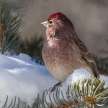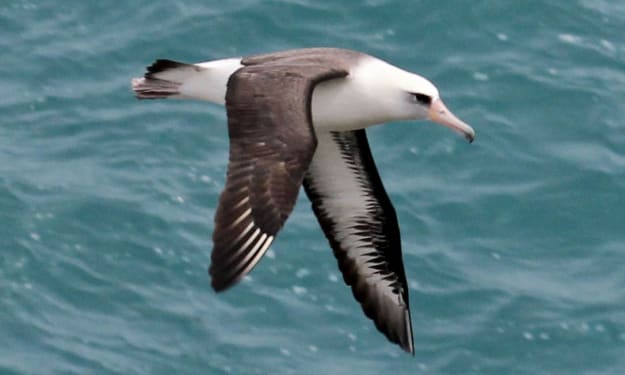
Cassin's finch (Haemorhous cassinii) is a member of the Finch family, Fringillidae. Along with the other "American rosefinches," this species is placed in the genus Haemorhous. Adults have white tail with narrow forked with brown eyes. They've got one bill longer than the lilac finch. Adult males are red with raspberry on the head, breast, back and rump; their back and undertail are streaked. The adult females have light brown upper parts and black underparts with white streaks running through; their facial markings are less distinct than those of the female purple finch. Cassin's finch may be among the most widespread and popular breeding birds in the coniferous belts of North America's western inland mountains. John Cassin of the Philadelphia Academy of Natural Sciences called this species the "greatest bird in the group" in a collection made by the Pacific Railroad Survey in the southwestern mountains in the early 1850's. At Cassin's behest, Spencer Baird pointed out the strikingly fresh finch to his friend and colleague. In appearance, plumage, and voice, in its limited western range, and in his preference for higher elevations when breeding, Cassin's namesake differs distinctly from his closest relative, the Purple Finch.
The rollicking song and the liquid tidilip calls are common to travellers to the Mountain Mountains, eastern Cascade Mountains, eastern Sierra Nevada and high points in between. Cassin's Finches gather in groups in late summer and early autumn, sometimes feeding in the company of crossbills and other mountain birds, and often visiting mineral deposits on the ground to fulfil a salt hunger that this species shares with other family members. In winter, the birds migrate to the south, to lower elevations. They may regularly visit bird feeders at this time before leaving for the high country early in spring, but their frequency at any given location is highly variable year after year. Despite the importance of this finch, relatively little detailed work has been carried out on it leaving a number of possibilities for new theories.
Males have red crowning with rosy breast wash; flanks are bright with only a few delicate stripes. Females are similar to Purple Finch but with more transparent face pattern and finer lines on the flanks. Both sexes are more common than House and Purple Finch to have pointed head and lengthier bill. Find in mountainous regions, mostly coniferous forests that move down to lower elevations in winter. Males, also wearing their first Prebasic moult drab brownish female-like garb in their first breeding season, sing more like older males, creating the misguided impression that both sexes sing with equal sophistication.
As a cadenza to their typical warm singing, Cassin's Finches often make an amazing sequence of imitations of other birds ' sounds; many field workers have hunted many species in vain, fooled by these excellent imitations. In western North American mountains their breeding area is coniferous forest as far south as northern New Mexico and Arizona; even past Baja California in southern California. Wide in size, they nest in conifers. They fly back down to lower elevations in winter. The northernmost breeding birds migrate south, as do some birds within the species range; other birds are permanent residents, however. Some birds which are not breeding as far south as winter in Central Inner Mexico.
Those birds are foraging in trees, sometimes on the field in seeds. They primarily feed on seeds, fruits, and berries, and some insects. They often live in small flocks while not nesting. This bird was named after John Cassin, who was director of the Philadelphia Academy of Natural Sciences. Cassin's finch was previously placed in the genus Carpodacus, along with the purple finch and house finch, along with the Eurasian rosefinches. The three North American species, however, are not closely related to the Old World rosefinch radiation, and thus most taxonomic authorities have assigned them to the genus Haemorhous.
About the Creator
MB
I am a bird aficionado and really enjoy spotting them them on hikes. I greatly appreciate the variety of birds cross North America and the world. They are amazing and intelligent creatures, each so unique and with a wonderful life.






Comments
There are no comments for this story
Be the first to respond and start the conversation.